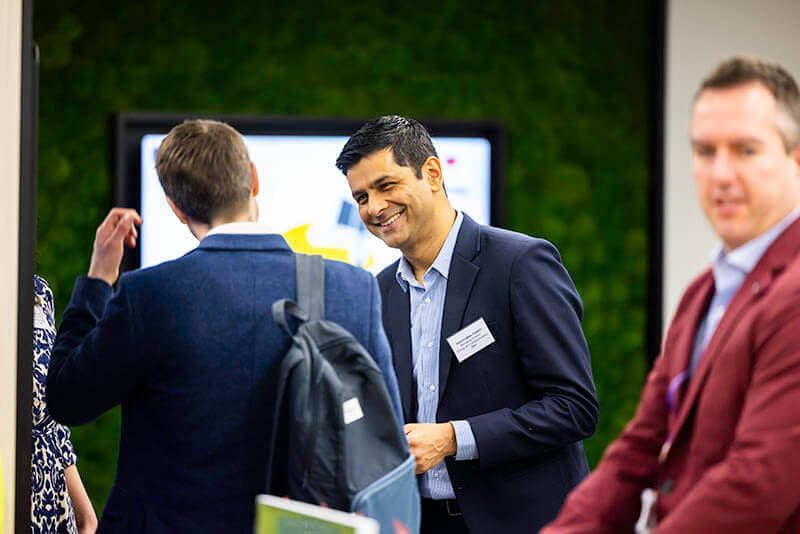FM’s role is key to delivering decarbonisation
With 60% of the UK’s large organisations now signed up to reach net zero, the race is most definitely on to adopt credible strategies and demonstrate progress on reducing emissions. However, the path is not straightforward and many face complex barriers to achieving net zero success. For example, how to build a credible business case and navigate the number of stakeholders involved in decarbonisation activities across an organisation.
In research conducted for Mitie, by Nordic Foresight, net zero and ESG are central to every conversation with industry leaders across the public and private sectors. And yet, according to Energy Monitor (2022), only 29% of UK organisations have committed to a net zero plan.
In the last in a series of webinars based on Mitie’s research, Jeffrey Saunders, CEO of Nordic Foresight, covers the latest thinking on decarbonising the built environment. And he discusses the challenges, and the role facilities managers must play in supporting net zero goals.

How the net zero challenge is transforming FM
The net zero journey aims to reduce greenhouse gas (GHG) emissions and remove what’s left, from the atmosphere, for storage in materials, plants, or in the ground.
According to a UKGBC report in 2021, the built environment contributes 42% of the UK’s total GHG emissions. Decision makers, including facilities managers, directly influence 25% of those emissions.
The challenge is to remove as much carbon as possible, from operations, before it gets into the atmosphere. And facilities managers are central to helping the UK meet the net zero targets set, by the government, for 2050.
It’s an ongoing challenge for organisations and presents an opportunity for facilities managers. It will fundamentally transform how we work. And how we buy and operate our assets, and report on their performance. We’ll have to change to help our organisations meet their net zero goals.
To meet the net zero challenge, our buildings and transport operations will need to be more efficient. We’ll have to change how our organisations use energy and we must find better ways to generate and store it.
We’ll need to collect better data from our assets, and back it up with careful analysis, to support the decision-making process at board level. And, with investors demanding greater compliance, at every turn, we’ll need more accurate reporting from our partners and suppliers.

Key considerations on your road to net zero
Every organisation will have to choose the best way forward based on their own situation. For example, your organisation might be considering switching to low-carbon energy sources or producing renewable energy on-site. Either way, your best solution will depend on factors including your net zero targets, your site location and environmental impacts.
On the road to achieving net zero there will be initiatives your organisation can take to speed up the process. Some will be low risk and best in times of rising energy costs. Other, more high-risk, initiatives will need a hard-nosed examination of investment plans and business models.
Improve the energy efficiency of your buildings
Many initiatives are about improving the energy efficiency of buildings. Introducing more LED lighting, addressing on-site heating and ventilation systems and generally improving the operations of our existing buildings. More organisations are considering on-site renewables and the opportunities for generating and storing energy to reduce reliance on the National Grid.
It’s unlikely that we’ll have an energy economy based on one source any time soon. In the medium term, we’ll rely on mixed sources including, on-site and offsite renewables, gas, fossil fuels and nuclear power.
Influence stakeholder behaviours
As an FM professional, you’re in a position to influence the behaviour of tenants, colleagues and suppliers. So, your role will involve a greater element of stakeholder engagement and management. For example, by encouraging employees to recycle and reuse materials, and generally creating better attitudes to waste management, you can reduce your organisation’s environmental impact.
Repair the old assets or acquire new ones
Embodied carbon in buildings is introduced during the construction phase and is essentially ‘embedded’ into the building fabric. As we reduce the carbon emissions from our operations, new buildings will become the greater source of embodied carbon.
For the embodied carbon in your existing buildings, choices will have to be made, balanced against factors like impact on investment. In some cases, it may be better to repair your existing assets, or find new ways to make them more efficient, rather than buying new ones. In others, you might need to close old buildings and move your organisation, or tenants, to a better site. These choices will also impact your building users and may need consultation and careful communication.
Take a holistic view of your buildings
Think of your buildings and building users as a set of interconnected and interactive systems. That’s everything: the building fabric, the building systems (like heating and lighting), the building management systems, the occupants, and the fixtures and fittings.
Each net zero initiative will have an impact on different parts of the whole system depending on how they interact. For example, if your organisation invests in an alternative heating system without considering the building insulation, the result could lead to low comfort levels for your colleagues.
We’ll need to take a more holistic approach, incorporating the interaction of the different ‘systems’, to avoid creating uninviting or uncomfortable buildings.
Buy with net zero in mind
Consider the fixtures, fittings and materials, used in your buildings and procure with net zero in mind. By reducing the need for raw materials, re-using products, repairing, refurbishing and repurposing, materials can be kept out of landfill and prevent carbon from entering the value chain. Also, you can work with your partners and suppliers to support them in their net zero journey.
It’s not only about your buildings
If your organisation has fleets of vehicles moving around a network, your transport operations may have a bigger impact than your buildings. In this case, you can find ways to set up more efficient networks and operations, with a focus on site locations, infrastructure and how your vehicles are fuelled.
Report for governance and assurance
The research shows that investors want to see evidence of greater compliance and more accurate reporting. So, the quality and accuracy of the data used to inform your organisation’s actions are vital. Make sure you have the right data in place to show how your organisation’s net zero and climate-based plans are having a positive impact.
Also, to factor scope 3 emissions into your organisation’s plans, make sure that your suppliers can provide accurate data on their own emissions.

How Mitie is accelerating on its path to net zero
Mitie’s team of Plan Zero consultants are specialists in the built environment, renewable energy, transport and e-mobility, and waste resources. We don’t just help our customers to set stretching net zero targets, we also help them bridge the gap between planning decarbonisation and actually achieving it.
As part of our own ambitious commitments to the government’s targets, we aim to be carbon net zero, for operational emissions, by 2025, and across our supply chain by 2035. That’s 15 years ahead of the government target date of 2050.
All the electricity that we buy for our controlled sites is 100% renewable. We’ve had a fleet of 3000 electric vehicles, and growing, since December 2022. Through our Connected Workspace services, we use building data, and actionable insights, to optimise the efficiency of our buildings and those of our customers.
Our Plan Zero consultants can put the decarbonisation of your built environment and fleet into action, solving problems so you can save money, reduce carbon and ensure energy security.
Supporting the net zero process in organisations, and informing high-level decision making, is a key part of the FM professional’s role.
Listen to the full webinar, for more on the latest thinking uncovered in our research with leaders in the decarbonisation race. And, learn what they are doing to accelerate their own organisation’s path to net zero.
Accelerate your pathway to net zero, is part of our Science of Service® series. The webinars showcase how technology, innovation and intelligence are pushing the boundaries and transforming facilities management.
Read next
Get ready for facilities transformation
How can FM leaders face the challenging headwinds of today’s business world head-on? In the Mitie Science of Service® white paper, we set out to highlight the most pressing issues in facilities management, and…

12 ways to save energy at work
If you have flown at night, you will have seen the cities below lit up like Christmas trees. It is a spectacular sight. On the other hand, it is also a stark reminder of…
Facilities Management will drive decarbonisation among businesses
As the UK approaches a year since the first national lockdown, and with a roadmap out of current restrictions recently published, the nation’s – and many business’ – attention is turning to building back greener.